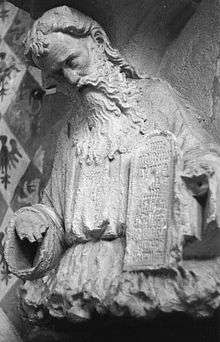Tablets of Stone
According to the Hebrew Bible, the Tablets of the Law as they are widely known in English, or Tablets of Stone, Stone Tablets, or Tablets of Testimony[1] (in Hebrew: לוחות הברית Luchot HaBrit - "the tablets [of] the covenant") in the Exodus 34:1, were the two pieces of stone inscribed with the Ten Commandments when Moses ascended biblical Mount Sinai as written in the Book of Exodus.
| Part of a series on |
| The Ten Commandments |
|---|
.tif.jpg) |
| Related articles |
According to the biblical narrative the first set of tablets, inscribed by the finger of God, (Exodus 31:18) were smashed by Moses when he was enraged by the sight of the Children of Israel worshipping a golden calf (Exodus 32:19) and the second were later chiseled out by Moses and rewritten by God (Exodus 34:1). Exodus 34:28 says the second set were written by Moses.
According to traditional teachings of Judaism in the Talmud, they were made of blue sapphire stone as a symbolic reminder of the sky, the heavens, and ultimately of God's throne. Many Torah scholars, however, have opined that the biblical sapir was, in fact, lapis lazuli (see Exodus 24:10, lapis lazuli is a possible alternate rendering of "sapphire" the stone pavement under God's feet when the intention to craft the tablets of the covenant is disclosed Exodus 24:12).[2]
According to Exodus 25:10-22 the tablets were stored in the Ark of the Covenant.
Appearance of the tablets

In recent centuries the tablets have been popularly described and depicted as round-topped rectangles but this has little basis in religious tradition. According to rabbinic tradition, they were rectangles, with sharp corners,[3] and indeed they are so depicted in the 3rd century paintings at the Dura-Europos Synagogue and in Christian art throughout the 1st millennium,[4] drawing on Jewish traditions of iconography.

The rounded tablets appear in the Middle Ages, following in size and shape contemporary hinged writing tablets for taking notes (with a stylus on a layer of wax on the insides). For Michelangelo and Andrea Mantegna they still have sharp corners (see gallery), and are about the size found in rabbinic tradition. Later artists such as Rembrandt tended to combine the rounded shape with the larger size. While, as mentioned above, rabbinic tradition teaches that the tablets were squared, according to some authorities, the Rabbis themselves approved of rounded depictions of the tablets in replicas so that the replicas would not exactly match the historical tablets.[5]
According to the Talmud, the length and width of each of the Tablets was six Tefachim, and each was three Tefachim thick - roughly 50 and 25 centimetres (20 and 10 in) respectively,[6] though they tend to be shown larger in art. Also according to tradition, the words were not engraved on the surface, but rather were bored fully through the stone.
Content
In Jewish religious tradition, the arrangement of the commandments on the two tablets is interpreted in different ways. Rabbi Hanina ben Gamaliel said that each tablet contained five commandments, "but the Sages say ten on one tablet and ten on the other".[7] Because the commandments establish a covenant, it is likely that they were duplicated on both tablets. This can be compared to diplomatic treaties of Ancient Egypt, in which a copy was made for each party.[8]
Christian replicas
Replicas of the tablets, known as tabots or sellats, are a vital part of the practice of Ethiopian Orthodox Church, which claims that the original Ark of the Covenant is kept in the Church of Our Lady Mary of Zion in Axum.[9]
In the Quran
Prophet
|
|---|
1.png) The name Musa written in Islamic calligraphy followed by Peace be upon him |
|
|
The Quran states that tablets were given to Moses, without quoting their contents explicitly:
- "And We ordained laws for him in the tablets in all matters, both commanding and explaining all things, (and said): 'Take and hold these with firmness, and enjoin thy people to hold fast by the best in the precepts: soon shall I show you the homes of the wicked,- (How they lie desolate).'" (Quran 7:145)
These tablets are not broken in the Quran, but picked up later:
- "When Moses came back to his people, angry and grieved, he said: 'Evil it is that ye have done in my place in my absence: did ye make haste to bring on the judgment of your Lord?' He put down the tablets, seized his brother by (the hair of) his head, and dragged him to him..." (Quran 7:150). "When the anger of Moses was appeased, he took up the tablets: in the writing thereon was guidance and Mercy for such as fear their Lord." (Quran 7:154).
Gallery
 Round corners, 13th century, France
Round corners, 13th century, France Round corners, c. 1390
Round corners, c. 1390 Sharp corners by Andrea Mantegna, c. 1461
Sharp corners by Andrea Mantegna, c. 1461 Sharp corners by Michelangelo, c. 1513-1515
Sharp corners by Michelangelo, c. 1513-1515.jpg) Moses receiving the tablets of stone, written by the finger of God
Moses receiving the tablets of stone, written by the finger of God
See also
- Tablet (religious)
- World's largest book, a stone book the pages of which are inscribed stone tablets
References
- Exodus 31:18
- See: Staples, W. E., "Lapis Lazuli", in The Interpreter's Dictionary of the Bible, vol.3, p. 72
- Bava Batra 14a.
- Except for a variant tradition where a scroll is shown, only known from Christian examples.
- See HaQoton, Reb Chaim "Squared vs. Rounded Tablets" (also available on academia.edu)
- Bava Batra 14a.
- Rabbi Ishmael. Horowitz-Rabin (ed.). Mekhilta. pp. 233, Tractate de-ba-Hodesh, 5.
- Margaliot, Dr. Meshulam (July 2004). "What was Written on the Two Tablets?". Bar-Ilan University. Retrieved 2006-09-20.
- Paul Raffaele, "Keepers of the Lost Ark?" Smithsonian Magazine, December 2007 (accessed 9 April 2011)